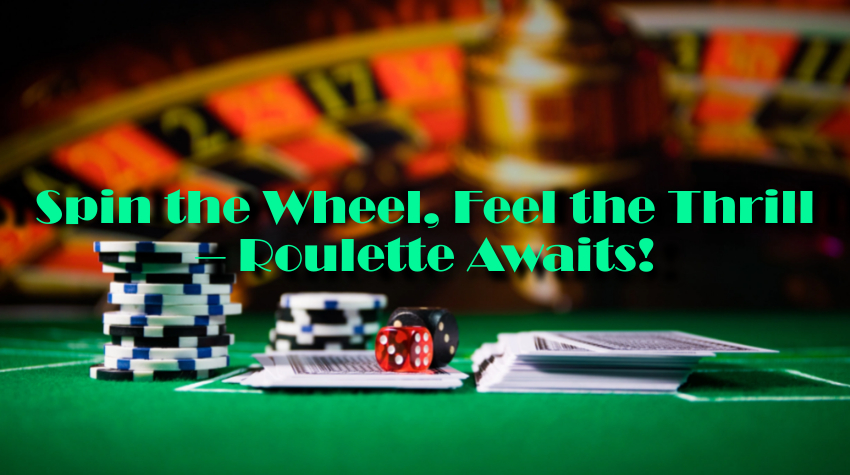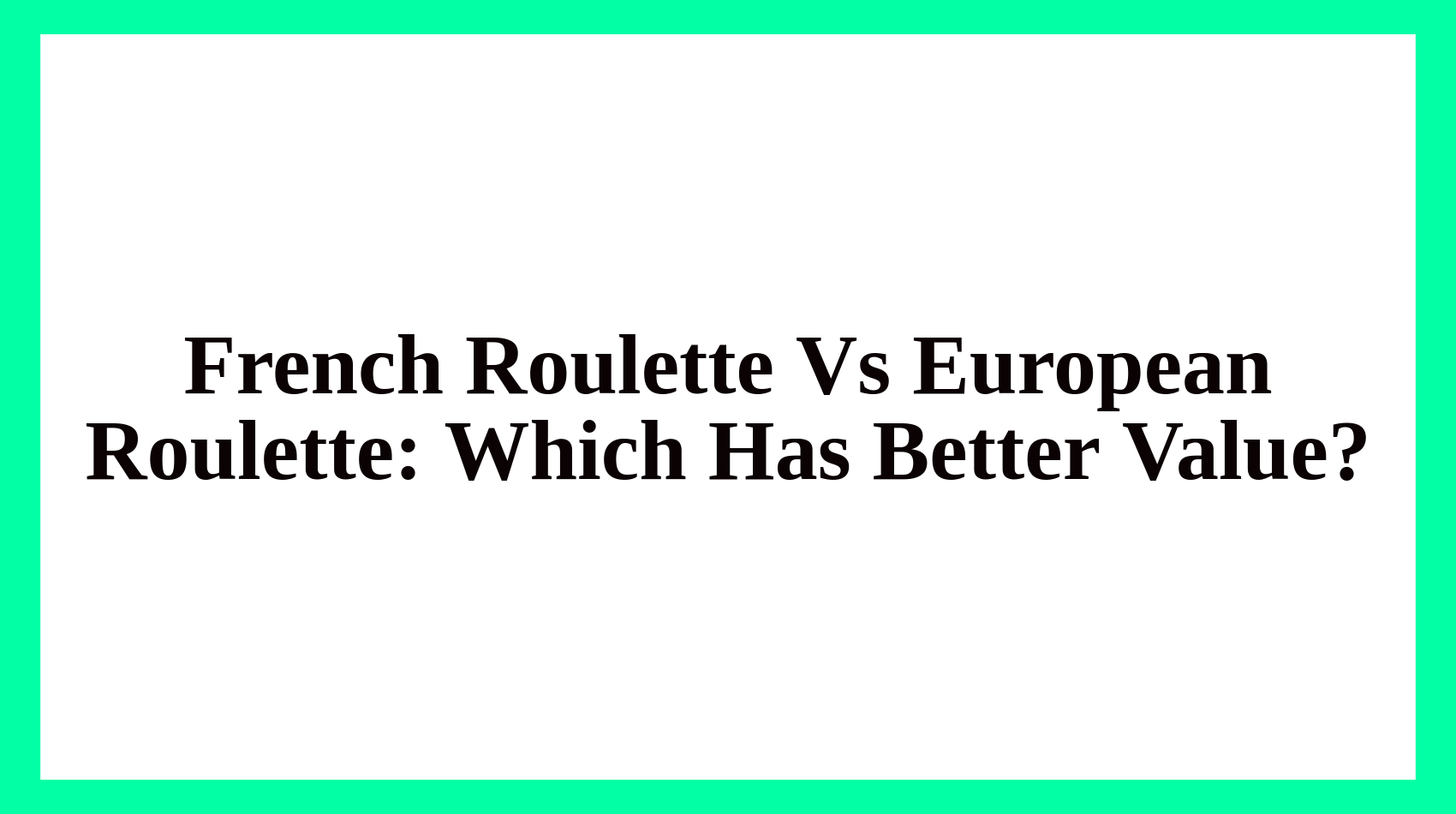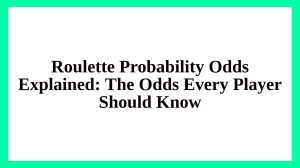Introduction: Two Classic Versions, One Important Question
Roulette is often called the “queen of casino games” — elegant, simple, and endlessly exciting. Among the different versions played worldwide, two stand out: French Roulette vs European Roulette.
To the untrained eye, they might look nearly identical. Both have a single zero, both use the same wheel layout, and both offer similar betting options. Yet, when it comes to player value and strategy, small rule variations can make a significant difference in your long-term results.
In this guide, we’ll dive deep into what separates French vs European Roulette, explore their unique features and rules, and determine which one gives players the better advantage.
If you’re completely new to roulette, you can first check out this beginner-friendly guide: What Is Roulette? before exploring the differences between these two advanced variations.
What Is European Roulette?
Overview and Origins
European Roulette is the version most players encounter in both land-based and online casinos across the globe. Its roots can be traced back to 18th-century France, when the first roulette wheels were introduced as a sophisticated gambling attraction among Europe’s aristocracy.
The defining feature of European Roulette is its single-zero wheel, which contains 37 numbered pockets (0–36). The introduction of the single zero was a pivotal innovation that set European Roulette apart from older versions and later influenced the creation of French Roulette.
Before the single-zero wheel, early versions of roulette had both a single and double zero, similar to modern American Roulette. The removal of the double zero in the European version effectively reduced the house edge, making the game more favorable to players and cementing its popularity across European casinos, particularly in Monte Carlo and London.
Wheel Design and Number Layout
The European Roulette wheel is not just a circle of numbers — it’s a carefully designed structure that balances odds and suspense. The 37 pockets are arranged in a specific sequence to ensure randomness and fairness:
- Numbers 1 to 36 alternate between red and black.
- The single zero (0) is green and serves as the casino’s advantage.
- Odd and even numbers, as well as high (19–36) and low (1–18) numbers, are distributed evenly around the wheel.
This balance ensures that no section of the wheel favors any particular outcome, making each spin entirely unpredictable and governed by chance.
Basic Rules of European Roulette
European Roulette follows a straightforward gameplay structure:
- Placing Bets – Players place their chips on the roulette table, selecting numbers, colors, or sections (such as dozens or columns). Bets can be made on single numbers or combinations to adjust the risk and payout.
- Spinning the Wheel – Once bets are placed, the dealer spins the wheel in one direction and launches the small ivory or resin ball in the opposite direction.
- Outcome Determination – When the ball lands in one of the numbered pockets, the dealer announces the result and pays out winning bets according to the paytable.
European Roulette is known for being one of the easiest games to learn. It combines simplicity with excitement, making it ideal for both beginners and experienced gamblers who enjoy a mix of chance and strategy.
Betting Options and Payouts
Players can choose from two main bet categories:
Inside Bets (higher risk, higher reward):
- Straight Up (single number) – Pays 35:1
- Split (two numbers) – Pays 17:1
- Street (three numbers) – Pays 11:1
- Corner (four numbers) – Pays 8:1
- Line (six numbers) – Pays 5:1
Outside Bets (lower risk, more frequent wins):
- Red or Black – Pays 1:1
- Odd or Even – Pays 1:1
- 1–18 (Low) or 19–36 (High) – Pays 1:1
- Dozen (1–12, 13–24, 25–36) – Pays 2:1
- Column (vertical column of 12 numbers) – Pays 2:1
House Edge and Player Value
European Roulette carries a house edge of 2.70%, which is significantly lower than that of American Roulette (5.26%). This advantage comes from the presence of only one zero instead of two.
To illustrate:
- In a single-zero game, your chance of winning an even-money bet (e.g., red or black) is 18/37, or roughly 48.65%.
- In a double-zero game, your chance drops to 18/38, or 47.37%.
That extra percentage difference might look small, but over hundreds of spins, it greatly impacts your long-term results.
Because of this lower house edge, European Roulette is often recommended for beginners who want to experience fair odds and develop confidence before exploring more complex variants.
What Is French Roulette?
Historical Background
French Roulette is the original version of the roulette game and the foundation upon which all other variations were built. It first appeared in 17th-century France, during a period when gambling was seen as both an elite pastime and a test of mathematical probability.
The word “roulette” itself means “little wheel” in French — a fitting description for a game that perfectly combines simplicity with sophistication.
Over the centuries, French Roulette evolved into a beloved casino staple across Europe. When it reached Monte Carlo in the 1800s, it became synonymous with luxury and high-stakes play. Even today, the French-style roulette wheel and table layout are regarded as the most elegant and refined versions of the game.
Visual Appearance and Layout
At first glance, French Roulette looks nearly identical to European Roulette. It also features a single-zero wheel with 37 pockets (0–36), maintaining the same balance of red, black, and green slots. However, the table layout and terminology make it unique.
The betting areas are labeled in French, preserving the game’s cultural heritage. Understanding a few key terms helps players adapt easily:
| French Term | English Equivalent | Meaning |
| Manque | Low (1–18) | Bets on low numbers |
| Passe | High (19–36) | Bets on high numbers |
| Pair / Impair | Even / Odd | Bets on number type |
| Rouge / Noir | Red / Black | Bets on color |
Though the layout may seem complex initially, it becomes intuitive with practice, and most online French Roulette tables now include bilingual labeling for easier navigation.
Unique Rules That Set French Roulette Apart
French Roulette is renowned for its two distinctive rules that dramatically reduce the casino’s advantage:
1. The La Partage Rule
When a player places an even-money bet (such as red/black or odd/even) and the ball lands on zero, the La Partage rule applies. Instead of losing the full amount, the player loses only half of their wager.
This rule instantly cuts the house edge from 2.70% down to 1.35% — making it one of the best odds in all of casino gaming.
Example:
You bet ¥1,000 on “red.” The ball lands on zero. Instead of losing ¥1,000, you lose only ¥500, and the other half is returned to your balance.
2. The En Prison Rule
In some variations, instead of splitting the bet, the casino may apply the En Prison rule. When the ball lands on zero, your even-money bet is “imprisoned” for the next spin.
If your bet wins on the following spin, you recover the full wager with no profit. If it loses again, the bet is forfeited.
This rule doesn’t just lower the house edge — it gives players a second chance to recover lost bets, making it ideal for conservative or strategic players.
House Edge and Statistical Advantage
The presence of these two rules is what makes French Roulette the most player-friendly roulette variant. With the La Partage or En Prison rule in effect, the house edge can drop to 1.35%, nearly half that of European Roulette.
This means that over the long run, French Roulette returns 98.65% of all bets to players, making it one of the most mathematically fair games in any casino.
Why French Roulette Is Popular Among Skilled Players
- Better Long-Term Value: The lower house edge makes it more favorable for serious players who play strategically.
- Classic Aesthetics: The traditional French layout, combined with the game’s historical roots, appeals to those who value authenticity.
- Gentle Learning Curve: While the terminology may seem intimidating, modern online platforms provide tooltips and English translations, making it easy to learn.
Key Takeaway
Both European Roulette and French Roulette share the same single-zero design, but French Roulette’s special rules (La Partage and En Prison) make it the clear winner in terms of player advantage.
For players in Japan looking for the best value and lowest risk, French Roulette provides not only a refined experience but also one of the best statistical chances to win in the long run.
French vs European Roulette: Key Differences
Although French Roulette and European Roulette look almost identical at first glance — both feature a single-zero wheel with 37 pockets (0–36) — their rules, payouts, and long-term odds tell a different story.
It’s in these small yet critical differences that French Roulette stands out as the version offering better long-term value and reduced house edge, especially for serious or strategic players.
Let’s break down these distinctions in more detail.
Comparative Overview
| Feature | French Roulette | European Roulette |
| Number of Pockets | 37 (0–36) | 37 (0–36) |
| Zero Pockets | Single Zero | Single Zero |
| House Edge | 1.35% (with La Partage or En Prison) | 2.70% |
| Special Rules | La Partage and En Prison | None |
| Table Language | French (Rouge, Noir, Pair, Impair, etc.) | English (Red, Black, Even, Odd, etc.) |
| Gameplay Pace | Slightly slower due to additional rules | Faster and simpler |
| Best For | Experienced or value-focused players | Beginners and casual players |
Both versions share the same layout and betting structure, but the special French rules significantly influence the game’s mathematics and player experience.
Why French Roulette Has a Lower House Edge
The biggest difference between French vs European Roulette lies in how they handle zero outcomes — the green pocket that gives the casino its advantage.
In both games, if the ball lands on 0, bets on red/black, odd/even, or high/low normally lose because zero belongs to neither category. However, French Roulette softens this loss through two special rules:
1. The La Partage Rule
When a player places an even-money bet (such as red/black, odd/even, or 1–18/19–36) and the ball lands on zero, they lose only half of their wager instead of the full amount.
This means:
- You risk less money per spin.
- Over time, you lose fewer units to the house.
- The house edge is effectively cut in half, from 2.70% to 1.35%.
Example:
If you bet ¥1,000 on “Red” and the ball lands on zero:
- In European Roulette → you lose ¥1,000.
- In French Roulette → you lose only ¥500 (half returned).
This may seem like a small difference, but in 100 spins, this rule can save you thousands of yen and significantly extend your playtime.
2. The En Prison Rule
This rule takes the player advantage one step further. When the ball lands on zero, your even-money bet is “imprisoned” for the next round instead of being lost or halved.
If your bet wins on the following spin, you recover your full stake with no profit. If it loses again, the entire bet is forfeited.
This mechanism gives you an additional chance to recover losses, making French Roulette especially appealing for disciplined, strategy-oriented players.
Long-Term Impact of the House Edge Difference
At first, a 1.35% vs. 2.70% difference may seem trivial. But in statistical terms, it’s extremely powerful. Let’s look at how it affects your bankroll over time.
Example Scenario: 1,000 Spins at ¥1,000 per Bet
| Version | House Edge | Expected Long-Term Loss |
| French Roulette | 1.35% | ¥13,500 |
| European Roulette | 2.70% | ¥27,000 |
In this example, a player betting the same amount under the same conditions loses twice as much on European Roulette compared to French Roulette over the same number of spins.
This illustrates why experienced players — especially those using flat betting or even-money systems like Martingale or Fibonacci — overwhelmingly prefer French Roulette for its superior long-term return.
Impact on Strategy and Betting Behavior
1. Risk Management
Because French Roulette reduces your losses on zero, it naturally supports low-volatility betting systems. Players can sustain longer sessions with less financial fluctuation.
2. Compatibility with Betting Systems
Popular roulette strategies — such as Martingale, Labouchere, or D’Alembert — perform more efficiently in French Roulette. Losing half instead of the full bet when zero appears minimizes the impact of losing streaks, keeping your bankroll stable.
3. Ideal for Consistent Players
Players who prefer even-money bets (Red/Black, Odd/Even) will see the most benefit. Over hundreds of spins, these rules lead to a smoother, steadier experience with fewer large losses.
4. Simplicity vs. Depth
While European Roulette is faster and easier to follow — perfect for new players — French Roulette offers greater depth for those who appreciate strategy and value optimization.
Table Design and Gameplay Experience
Another subtle but important difference lies in the table design and atmosphere:
- French Roulette tables tend to be larger, with a more traditional layout featuring French terms like Manque (1–18), Passe (19–36), and Pair/Impair. Dealers often use French phrases, giving the game an elegant and classic ambiance.
- European Roulette tables are more compact, streamlined, and labeled in English, emphasizing simplicity and accessibility.
In modern online casinos, both versions are available in digital and live-dealer formats. Many Japanese players enjoy French Roulette Live by providers like Evolution Gaming or Playtech, where the rules and interface highlight La Partage visually for clarity.
Which Version Is Better for You?
| Player Type | Recommended Version | Reason |
| Beginner | European Roulette | Simple rules, fast pace, English layout |
| Casual Player | European Roulette | Easier to follow, fewer rule variations |
| Experienced Player | French Roulette | Lower house edge, deeper strategic value |
| Long-Term Strategy Player | French Roulette | Better protection against zero outcomes |
Ultimately, both versions share the same excitement and simplicity, but French Roulette rewards patience and smart play — making it ideal for players who want to maximize their return and minimize long-term losses.
Final Thoughts on the Difference
In summary, the French vs European Roulette comparison comes down to one essential factor — the zero rules. Both versions use the same wheel, but French Roulette’s La Partage and En Prison rules dramatically change the math in your favor.
For casual players who prefer fast, straightforward action, European Roulette is an excellent choice.
For value-driven players who think long-term, French Roulette is the clear winner, offering nearly double the return efficiency per spin.
When you understand this difference, you’re not just spinning the wheel — you’re playing smarter.
Betting Options in Both Versions
Inside Bets (Higher Risk, Higher Reward)
| Bet Type | Description | Payout |
| Straight Up | Bet on a single number | 35:1 |
| Split | Bet on two adjacent numbers | 17:1 |
| Street | Bet on a row of three numbers | 11:1 |
| Corner | Bet on a block of four numbers | 8:1 |
| Line | Bet on two adjacent rows (six numbers) | 5:1 |
Outside Bets (Lower Risk, Lower Reward)
| Bet Type | Description | Payout |
| Red / Black | Choose color | 1:1 |
| Odd / Even | Choose number type | 1:1 |
| Low / High | Choose 1–18 or 19–36 | 1:1 |
| Dozen | Bet on groups of 12 numbers | 2:1 |
| Column | Bet on vertical columns | 2:1 |
Both French vs European Roulette offer these options, but the zero rules in French Roulette provide an extra layer of protection on even-money bets, making it the superior choice for strategic players.
The Role of House Edge and Player Value
European Roulette: Balanced and Accessible
European Roulette’s 2.7% house edge already offers solid value for players compared to other games like slots or American Roulette (5.26%). It’s ideal for those who want straightforward gameplay without additional rules.
French Roulette: The Best Odds in Roulette
With a reduced house edge of 1.35%, French Roulette stands as one of the lowest-edge casino games in existence. This means players retain 98.65% of their wagers on average — an exceptional figure for a casino game based on chance.
Strategy Tips for French and European Roulette
1. Focus on Even-Money Bets
Whether you’re playing French or European Roulette, sticking to even-money bets (Red/Black, Odd/Even, High/Low) offers the best long-term returns.
2. Take Advantage of La Partage and En Prison
In French Roulette, always choose tables where these rules apply. They are mathematically beneficial and significantly lower the casino’s advantage.
3. Avoid the Temptation of “Lucky Numbers”
Betting on favorite numbers or patterns might be fun, but it doesn’t improve odds. Both versions rely on pure probability — each spin is independent.
4. Manage Your Bankroll
Because roulette can shift quickly between wins and losses, set a fixed betting limit and pace your wagers to maximize playtime and enjoyment.
Which Version Offers Better Value?
French Roulette: The Clear Winner
When it comes to house edge, betting rules, and player protection, French Roulette easily outperforms its European counterpart. The La Partage and En Prison rules ensure that even when luck isn’t on your side, you lose less in the long run.
European Roulette: The Simpler Choice
However, for beginners or players who prefer a faster game without extra rules, European Roulette remains an excellent option. Its clean layout and familiar English terms make it easy to understand and play.
Final Comparison at a Glance
| Category | French Roulette | European Roulette |
| House Edge | ✅ 1.35% | ❌ 2.70% |
| Complexity | Slightly higher | Easier for beginners |
| Payouts | Same base payouts | Same base payouts |
| Rule Advantage | La Partage / En Prison | None |
| Ideal For | Experienced or value-conscious players | Beginners or casual players |
Conclusion: Choose the Roulette That Fits Your Style

\ Spin the Wheel, Feel the Thrill /
Both French and European Roulette share the same elegant structure and thrilling gameplay, but when it comes to value and player advantage, French Roulette stands out as the superior choice.
Its reduced house edge and fairer rules make it ideal for players seeking smarter bets and longer playtime.
For Japanese online casino players who enjoy roulette for strategy as much as entertainment, understanding these subtle differences can elevate your gaming experience.
To learn more about roulette variations, winning strategies, and casino insights, visit Casino Savvy — your trusted source for casino tips and expert guides.









Comments